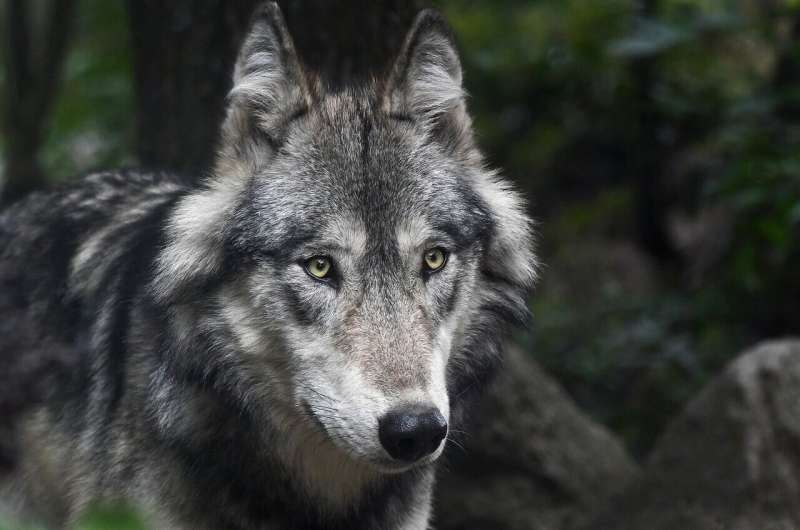Credit: CC0 Public Domain
An endangered female gray wolf known as OR-54 didn't live long enough to find a mate, despite making an 8,700-mile meandering journey through three states looking for one.
On Wednesday, California wildlife biologists found the lonesome wolf's carcass in Shasta County. It's not clear if the wolf died naturally, accidentally, or is the second California wolf to be killed by a poacher in as many years.
She was 3 or 4 years old. Her well-chronicled odyssey became an object of fascination among environmentalists and animal rights advocates. But she had plenty of detractors as well—notably, north state ranchers who blamed OR-54 for killing their livestock.
Biologists with the California Department of Fish and Wildlife are likely to perform an examination on the remains at their wildlife investigations lab in Rancho Cordova in the coming days.
OR-54's remarkably long journey began in October 2017 when Oregon wildlife biologists captured her and put a GPS-tracking collar around her neck. The No. 54 signifies she was the 54th wolf collared in that state.
As a member of the southern Oregon Rogue Pack, OR-54 came from a famous sire. She was the offspring of OR-7, the first known wolf to return to California after they were killed off early last century.
OR-7 crossed into California in late 2011, becoming an instant sensation as he spent months wandering around the northeastern part of the state before heading back into Oregon to start the Rogue Pack. His arrival eventually prompted California's Fish and Game Commission, over the objections of ranchers and deer hunters, to vote to protect gray wolves under the state's Endangered Species Act.
OR-54 followed in OR-7's path into California looking for a mate or a new pack.
On Jan. 24, 2018, she crossed the Oregon border into eastern Siskiyou County, not far from where OR-7's GPS collar showed he'd entered the state years earlier.
Her journey took her farther south than any of the 30 or so wolves that biologists estimate have either passed through, settled or been born in northeastern California since OR-7's visit.
On June 8, 2018, she came within 1 { miles of the Boreal Mountain ski area. She crossed briefly into Nevada. She made two trips back to Oregon. In California, her collar showed she'd traveled through Butte, Lassen, Modoc, Nevada, Plumas, Shasta, Sierra, Siskiyou, Shasta and Tehama counties.
As of December, her collar showed she covered at least 8,712 miles, an average of 13 miles per day, since she first stepped into California.
A few times her journeys took her into the territory of the Lassen Pack—a small family group that's settled in Lassen and Plumas counties. The Lassen Pack is the only known wolf pack currently in California.
The Lassen Pack's matriarch has her own GPS collar. In July, the two collars showed OR-54 approached the pack, but apparently they didn't hit off.
She returned to her wanderings after just a few hours.
OR-54's journey also included some tense encounters with people as she passed through public and private forest lands where ranchers have for generations kept cattle in pastures and on the open range.
OR-54 was suspected in at least five different attacks on livestock in Plumas County last year, according to incident reports biologist post on the state's wolf website.
After a rancher found a wolf feeding on two calf carcasses in Plumas County last March, GPS tracking data revealed that OR-54 had been "in the immediate area" that morning, according to a Department of Fish and Wildlife report.
In August, investigators found evidence that OR-54 was suspected of killing two calves and injuring a third. In September, she approached a cow and her 2-hour-old calf, but only consumed "part of the placenta" likely because the protective cow drove the wolf away, the agency said.
Since wolves returned to California, there have been at least 15 confirmed or probable cases of wolves preying on livestock.
In December, OR-54's collar stopped sending out readings for several weeks, but it recently sent out a signal alerting biologists to an approximate location where they found the carcass, said Jordan Traverso, a spokeswoman for the Department of Fish and Wildlife.
She declined Thursday to elaborate on where OR-54 was found in Shasta County or provide other details, citing the pending death investigation. In a news release, her agency warned that the state's game wardens take "very seriously any threats to this recovering wolf population."
"We remind the public that killing a wolf is a potential crime and subject to serious penalties including imprisonment," the release said.
Those warnings come as California wildlife officers continue to investigate the unsolved killing of another wolf in 2018
On Dec. 2, 2018, Oregon wildlife biologists notified California officials that a black-furred yearling male they'd labeled OR-59 had traveled from a pack in northeast Oregon and crossed the state line into Modoc County.
Three days later, the wolf was spotted by a rancher feeding on a calf, which investigators later determined may have died from pneumonia.
Then, on Dec. 9, 2018, Oregon biologists received a "mortality signal" from its collar indicating the wolf had died, according to the California Department of Fish and Wildlife.
In the year since, California's wildlife officers revealed little about the case, including where OR-59's body was found, how the wolf died or why they found its death suspicious.
In a news release last month announcing a $2,500 federal reward, the U.S. Fish and Wildlife Service provided more details.
The wolf was shot once with a .22-caliber center-fire rifle along County Road 91 near the small communities of Lookout and Bieber, the wildlife agency said.
The same week, the Center for Biological Diversity, an Arizona-based environmental group, offered its own reward of $5,000.
©2020 The Sacramento Bee (Sacramento, Calif.)
Distributed by Tribune Content Agency, LLC.























